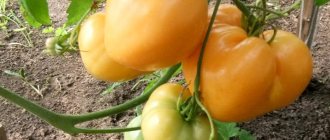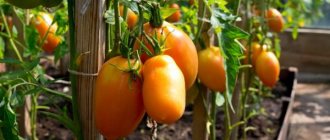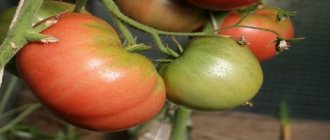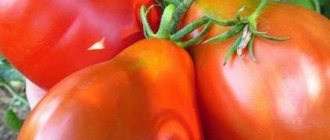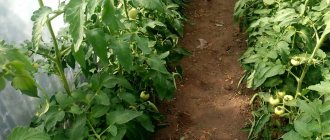Advantages and disadvantages of the variety
Size of tomatoes
Having familiarized yourself with the characteristics of this type of tomato, you can safely highlight its disadvantages and its advantages.
First, let's talk about the advantages:
- Caring for seedlings is not difficult.
- This variety is immune to common diseases. This includes tobacco mosaic virus, late blight, and alternaria. These diseases most often affect tomatoes. The fact that Lyrica is not under their control makes the variety even more valuable.
- The plant does not require frequent treatment for pests. This can only be done a few times per season.
- The variety is not capricious regarding growing conditions. He is quite unpretentious. It can be grown in greenhouses and in the garden.
- Brings a big harvest.
- Ripening takes only about 80 days.
- Tomato fruits are not only beautiful and neat, but also very tasty, since the tomato has a sour taste.
- Lyrica tomato fruits are universal, as they can be used both fresh and cooked. The only thing is that this species is not suitable for cooking tomatoes, because it has rather stringy fruits.
- Long shelf life compared to other tomatoes. It is two weeks. But there is one exception: in order to have the same shelf life, tomatoes should be picked unripe.
- Tomatoes of this type have good transportability.
The most interesting thing is that this type has no disadvantages. This further explains why Lyrica is so popular.
Characteristics of tomato Lyrica
To better understand the features of a new tomato variety, it is necessary to study its main characteristics. How abundantly does Lyrica bear fruit, and what advantages and disadvantages does the variety have?
Productivity
From the point of view of fruiting and productivity, Lyrica can be considered one of the most profitable tomato varieties. From the moment the seeds are planted to the appearance of the fruit, very little time passes - only 78 days. Bushes of this variety produce a lot of tomatoes - up to 15 kg per bush, up to 20 kg per 1 square meter. m.
Considering the good preservation of the fruits and their high transportability, when growing the Lyrica variety, you can both provide yourself and your friends with tomatoes, and successfully send tomatoes for sale.
Area of application of fruits
Characteristics and description of the Lyric tomato classify the variety as universal. This means that you can use tomatoes completely freely - eat them fresh in salads, add them to snacks, and also can them or heat them. However, it is not recommended to use tomatoes to create juice. Since Lyrica f1 tomatoes are very fleshy, the juice will be appropriate - with pulp.
Resistance to diseases and pests
Among the main advantages of the Lyrica variety, one can note increased resistance to:
- tobacco mosaic virus, which infects the tops;
- late blight - a fungal disease that causes rot and drying out;
- Alternaria blight is another fungal disease that affects leaves, stems and fruits.
The listed diseases especially often harm tomatoes, so it is very valuable that the variety is not susceptible to them.
Attention! This does not negate the need to take preventive measures against other diseases and pests.
Tomatoes must be regularly inspected and treated with Bordeaux mixture, copper sulfate solution and home remedies - for example, based on laundry soap or garlic.
Advantages and disadvantages of the variety
Having familiarized yourself with the characteristics and features that Lyric tomatoes have, you can briefly highlight their main advantages and disadvantages.
The advantages of the variety certainly include:
- High immunity to common diseases that affect tomatoes - it’s easy to care for seedlings.
- Unpretentiousness to growing conditions - the variety is suitable not only for greenhouses, but also for open-air beds.
- Early ripening and yield - the full ripening cycle takes only 78 days, the variety bears fruit very abundantly.
- Beautiful, neat and juicy fruits with excellent taste - Lyrica has an unusual but pleasant sourness.
- Versatility - tomatoes can be used in any form, fresh or processed.
- Quite a long shelf life - up to 2 weeks - and good transportability.
The description of Lyric tomatoes is practically free of flaws. The only thing that can be attributed to the disadvantages of the Lyrica tomato is the modest size and light weight of the fruit. However, this feature is compensated by abundant fruiting - small tomatoes in significant quantities completely cover the need for tasty fresh tomatoes.
Productivity
harvest from 1 bush
As already determined above, the harvest is large, so this variety is considered one of the most profitable tomatoes.
The yield of the variety in open ground is about 10 kg per square meter, in protected ground up to 15 kg/m². Considering this feature of the variety, you can feed it to your loved ones and friends, as well as send it for sale.
Landing rules
How to plant Lyrica F1 tomatoes? Agronomists do not recommend planting seeds in open soil; be sure to prepare seedlings! Ripening seedlings in a separate container with a nutrient substrate will avoid damage to plants from the negative influence of the external environment. Planting tomatoes in the warm season will not damage the stems from frost and will allow you to reap a good harvest.
A few basic rules for planting Lyric tomatoes:
- Four to five stems are planted per square meter. No more is needed - the plants will not have time to ripen, the root system will be cramped.
- Tomatoes are formed into four stems. If one of the stems has grown too early and has stopped growing, another one can be formed. Thus, up to twenty kilograms of tomatoes are harvested from one square.
- The tomato does not need to be tied up - up to six fruits ripen on a strong cluster, they rarely fall to the ground.
- The Lyric variety can also be grown in open soil without loss of yield. You can harvest only 1 kg less per square meter than with greenhouse planting. But tomatoes ripen faster in a greenhouse.
To protect against sudden temperature changes or when the soil is poor, you can fertilize the soil with special compounds. Whether or not to mulch the soil is the choice of the summer resident. A good productive hybrid will ripen under such conditions. But if you know that frost may strike, then it is better to lay paths between plantings with straw.
Features of cultivation
bush in OG
As we have already learned, planting is carried out both in the open air and in greenhouses. In such cases, seeds are planted first. They do this in warm and fertilized soil, in small boxes.
Seeds are planted for seedlings in early spring. The seedlings will be able to sprout when the soil becomes completely warm and warms up.
After the sprouts appear in the boxes, the ground has finally thawed after the winter season, thin out the seedlings and plant them in moist soil. But loosen it first.
Plant tomatoes in soil that has been fertilized before. Tomatoes should be planted in small holes of five sprouts per square meter.
After planting, water thoroughly and treat against pests.
Pest and disease control
Preventive treatment of Lyric tomato with fungicides is carried out in early May, a few days before transplanting the seedlings. To prevent the development of fungal infections, you can use any proven drug:
- "Ordan";
- "Fitosporin";
- "Skor";
- "Maksim";
- "Fundazol".
Insects can be quickly destroyed using insecticides (especially in the initial stages of the invasion):
- "Decis";
- "Karbofos";
- "Spark";
- "Match";
- "Ephoria";
- "Fitoverm".
Folk remedies also help to cope with pests - a decoction of potato tops, an infusion of chopped garlic, chili pepper, a solution of soap shavings with wood ash and others.
Important! Treatment of Lyrica tomato bushes is carried out in dry weather, in the absence of strong wind, preferably in the evening. After using chemicals, it is important to start harvesting fruits no earlier than 2-3 days later.
Plant care
formed bushes in a greenhouse
There are some other rules of care that require you to strictly follow:
- Watering should be done as needed or when the soil begins to dry out. Tomatoes love moisture very much, so watering should be done no more often and no less than twice a week, twice a day. It is especially important to monitor humidity during ripening, because during this period the plant needs water most. This is necessary for the tomato to fully ripen.
- As your tomato bush grows, you should inspect it and trim off unnecessary things. It is best to leave no more than four stems on the bush so that the development of tomatoes does not slow down. And if you do not listen to this advice, then there is a high probability that the yield will be unsatisfactory.
- Seedlings should be weeded as often as possible to avoid the appearance of weeds that will negatively affect the development of the plant.
- Another very important procedure for a tomato plant is pinching. All tomato shoots that do not participate in the development of the fruit must be removed. Otherwise, the “stepchildren” will begin to grow without control, and then the main plant will be deprived of moisture and nutrients.
- The grown shoots should be strengthened and tied to a support.
- If you think that the soil is not nutritious, then it should be fed with potassium or nitrogen fertilizers.
Transplantation and subsequent care
It is better to plant in a greenhouse or open ground in cloudy weather.
2 weeks after transplanting, the beds need to be dug up and fertilized. Before planting, seedlings are treated with a solution of potassium permanganate. The holes are made according to the scheme of 5 bushes per 1 m2. Tomatoes are planted in well-watered holes, then the beds are covered with mulch. Only after 7-10 days can they be watered.
Abundant sprinkling is carried out once every 5-7 days. Every 2 weeks, tomatoes are fed with mineral fertilizers and folk remedies.
It is better to form Lyrica bushes into 4 stems. Remove yellow leaves periodically.
Reviews from gardeners who planted the Lyrica variety
Sergeev Vladislav Anatolyevich, living in the city of Penza, shared his review:
“I recently tried to plant the Lyrica tomato variety for the first time. I planted it on my summer cottage, and now I can call it one of my favorite tomatoes. I was shocked by its rapid development. The fruits it produces are not large, but they are very juicy and tasty. And by the way, they are beautiful. They can be stored for quite a long time and can be used however you like.”
Astakhova Anna Petrovna, Ryazan:
“I once heard positive reviews about this variety. I decided to plant it in my greenhouse. I was absolutely delighted. The tomatoes ripened in just three months. She reaped a truly excellent harvest. One bush yielded 19 kilograms of tomatoes. I also liked the taste. He's quite unusual. Sweetish, but at the same time has some sourness.”
Rimma, from the city of Daugavpils, shares:
“I really liked the Lyrica tomato variety, I will plant it next year. The harvest is, of course, excellent, and so is the taste.”
Natalya, Rostov-on-Don:
“I saw a photo of the Lyrica tomato variety, I really liked its characteristics, after that I decided to try planting tomato seeds in the soil and not in a greenhouse. The tomatoes completely met all my expectations. Despite the fact that the spring was quite cool, the tomatoes ripened in 78 days, fulfilling their promise. From each bush I collected about fifteen kilograms of tomatoes. This is very good for the garden.”
Alena, from the city of Ryazan shared:
“Quite a long time ago I wanted to plant an early-ripening tomato on my plot, but I couldn’t find one that was suitable in terms of taste. The choice was quite narrow, since I do not have a greenhouse. And finally, last year, I was able to plant the Lyrica tomato variety for the first time. I was very pleased. The taste is like summer tomatoes, the smell is pleasant, the tomato itself is not watery, but rich. It is generally very easy to care for. In open-air soil, seedlings began to grow even without fertilizers. We collected about 40 kilograms. I rolled some and used some in salads. So I liked the taste in salads the most.”
Description of tomato Lyrica
Lyrica is an early ripening and unpretentious tomato variety, bred agro from the Moscow region quite recently, only in 2021. When creating the hybrid, specialists tried to obtain a high-yielding, tasty and undemanding variety in terms of growing conditions - and achieved their goal. The Lyrica tomato is equally suitable for both greenhouse conditions and open ground, therefore it is extremely popular among gardeners.
In fact, the hybrid is a low plant, reaching a little over half a meter in height. The tomato bush is small in size and compact. Despite its small height, in the last stages of growth its stems need gartering, since they cannot support the weight of the fruit on their own.
Fruit inflorescences on the stems of Lyrica are formed above the 4th leaf from the ground and then go through the leaf. Each inflorescence consists of several flowers, which subsequently form fruits - up to 8. When growing tomatoes of this variety, you can allow the inflorescences to develop independently, or you can thin them out to form larger and heavier fruits.
Description of fruits
An early ripening tomato variety produces fruits within 78 days after planting the seeds - and at the same time, the tomatoes ripen evenly and at the same time. In appearance, ripe fruits are very beautiful - round, with small protrusions near the stalk, they have a bright red rich color and a dense shiny skin. There is no green spot at the point of attachment of the tomato to the stem during the ripening period - the shade of the fruit remains uniform.
The tomato pulp is juicy and without voids. The taste is slightly sour, but this does not spoil the tasting qualities of the variety, but only gives Lyrica a pleasant uniqueness.
One tomato of this variety can weigh about 130 g. The fruits are stored well and for quite a long time, they are not prone to cracking and therefore do not rot for several weeks.
Agrotechnical features and opinions of gardeners
Lyrica F1 tomato breeders recommend paying attention to some nuances when growing and following simple instructions. After all, only by following the rules of agricultural technology can you expect to get maximum results from your tomato.
- plant seedlings in the first half of May and preferably on the sunny side;
- a higher yield will be when the plant is formed into 3-4 stems;
- per 1 sq.m. It is allowed to place 5-6 bushes of soil;
- when planting in open beds, you need to take into account that ripening will be about 2 weeks later than in a greenhouse;
- the lower leaves touching the ground must be removed.
Experienced gardeners evaluate the Lyrica tomato as follows.
Dmitry from Penza writes: “I’ve been selecting tomato hybrids for my collection for a long time, and this year I learned about Lyrica. Grown both in a greenhouse and in open ground. The yield in both cases was very high. I would especially like to point out that the tomato did not suffer from anything during the entire season, and there was little trouble with it. The taste may not be “super”, but for early tomatoes it’s not bad at all.”
Anna from Ryazan shares: “I was happy about the good germination of the seeds; lately there have often been disappointments about this. The yield was impressive, but they seemed kind of plastic to me, but all worries dissipated after I tried the tomato. It turned out to be juicy and moderately sweet. I put it in jars for the winter, I’ll see what the marinade tastes like.”
Lilia from the Moscow region: “I planted Lyubasha from “Partner” last year, and this season I chose Lyrica. They are like twin sisters. I don’t even know which hybrid I liked better.”
In addition to the reviews, we recommend that you familiarize yourself with the visual video of the full tomato growing cycle and see for yourself what results an amateur vegetable grower has achieved in his greenhouse.
Agricultural technology
The described hybrid is not recommended to be planted by direct sowing of seeds into the soil. For early ripening, you need to plant pre-grown tomato seedlings. Seed preparation and seedling cultivation are carried out according to the standard scheme. Seedlings should be ready for transplanting in about 55–60 days. Calculate the sowing time taking into account the growing conditions. The recommended planting density is 4 pieces per 1 square meter in a greenhouse, and no more than 5 pieces per 1 square meter. meter on the street. It is recommended to tie the plants to a support, otherwise the heavy ripening clusters may overhang and bend the stem. In a greenhouse, the variety can be formed into 3 - 4 stems, sometimes formation into 5 stems is allowed. In an open garden bed, Lyrica is formed into 2–3 stems so that the crop has time to fully ripen on the bush. Although it has been experimentally proven that even 4 stems (but only in warm regions) can produce wonderful results. Stepping is carried out moderately or not at all. Further care for tomatoes is not difficult. Watering in the greenhouse and outside is carried out as the top layer of soil dries. In an open garden, natural precipitation must be taken into account. Fertilizers are applied mainly by universal ones, having a balanced composition. Weeding and loosening the soil after watering are also included in standard agricultural practices.
Lyrica is an excellent variety for an open garden bed or protected ground. The unusual thing about this variety is that in a greenhouse and in an open garden bed it always produces the same high yield. In protected soil, the yield can be higher by a little more than a kilogram, but tomatoes grown under real sun have better taste. Resistance to fungal and viral diseases will allow you to use garden chemicals less often, so the harvest can be environmentally friendly and truly beneficial to health. The fruits are equally good in their natural form and processed. No critical deficiencies were identified during cultivation. The only big disadvantage of the hybrid is the still high price of seed material and the need to constantly purchase seeds.
Tags: early



